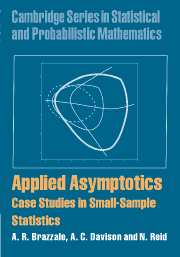
-
Select format
-
- Publisher:
- Cambridge University Press
- Publication date:
- November 2009
- May 2007
- ISBN:
- 9780511611131
- 9780521847032
- Dimensions:
- (254 x 278 mm)
- Weight & Pages:
- 0.604kg, 248 Pages
- Dimensions:
- Weight & Pages:
You may already have access via personal or institutional login
Book description
In fields such as biology, medical sciences, sociology, and economics researchers often face the situation where the number of available observations, or the amount of available information, is sufficiently small that approximations based on the normal distribution may be unreliable. Theoretical work over the last quarter-century has led to new likelihood-based methods that lead to very accurate approximations in finite samples, but this work has had limited impact on statistical practice. This book illustrates by means of realistic examples and case studies how to use the new theory, and investigates how and when it makes a difference to the resulting inference. The treatment is oriented towards practice and comes with code in the R language (available from the web) which enables the methods to be applied in a range of situations of interest to practitioners. The analysis includes some comparisons of higher order likelihood inference with bootstrap or Bayesian methods.
Reviews
'…I welcome this book and wish it well in achieving some inroads into practical use of a large area of theoretical developments.'
Source: Journal of Applied Statistics
'This is a very welcome book, on a very important topic.'
Andrew Robinson - University of Melbourne
'This is an excellent book for applied statisticians. It presents application of higher order asymptotic theory in likelihood in many different contexts. … I highly recommend the book to researchers looking for ways to improve accuracy in statistical testing. The book is well written, the examples are clear and because all examples can be verified by the reader through the provided packages and code in R, the analyses can be explored in great detail.'
Source: Biometrics
Contents
Metrics
Altmetric attention score
Full text views
Full text views help Loading metrics...
Loading metrics...
* Views captured on Cambridge Core between #date#. This data will be updated every 24 hours.
Usage data cannot currently be displayed.
Accessibility standard: Unknown
Why this information is here
This section outlines the accessibility features of this content - including support for screen readers, full keyboard navigation and high-contrast display options. This may not be relevant for you.
Accessibility Information
Accessibility compliance for the PDF of this book is currently unknown and may be updated in the future.


